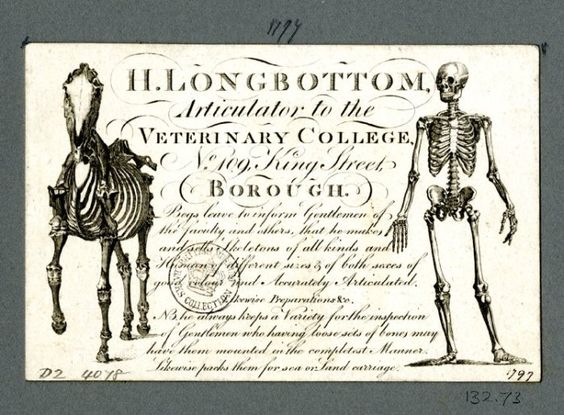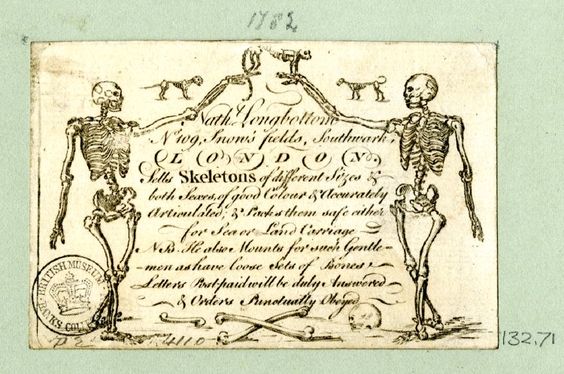Human Skeletons for Sale
In the age of enlightenment, people learned about anatomy from more than just books. The use of articulated skeletons dates back to at least 1543, and by the 18th century, there were purveyors of this somewhat gruesome commodity such as Nathaniel Longbottom, whose card appears at right. Medical schools flourished in Europe in the 18th century, and as anatomy was a required course, businessmen such as Longbottom and his son identified the scholarly need for human skeletons and met the demand. Doctors of the era would also often display a skeleton in their office as a status symbol indicating they had been properly and formally educated in the medical arts.
So what is an articulated skeleton and where did the “donors” come from?
An articulated skeleton was one that had been defleshed, degreased, and reconnected so as to show normal relationships and movement of the bones as in a living body. There was actually a 1790 pamphlet written by Thomas Pole called The Anatomical Instructor with directions on how to do this.
Before the Anatomy Act of 1832, the only legal source of skeletons in the UK was from those condemned to “death and dissection” by the courts. One usually needed to be convicted of a harsher crime to receive the sentence of dissection. As medical schools expanded, the need for cadavers could not be met through legal means so the practice of body snatching, which was only a misdemeanor punishable by a fine, became more prevalent. Body snatchers, also known as “resurrection- ists” would dig at the head of the grave, or tunnel in from 15-20 feet away, using a wooden shovel, which was quieter than metal, and when they reached the coffin would break it open at the end and attach a rope to the body and drag it out. They were careful not to steal jewelry or clothing, as that would have been a felony, perhaps resulting in their being the next “donor!”
To thwart this practice, relatives would often keep watch over their loved one’s body for a few weeks after the burial and sometimes iron coffins or a framework of iron bars called a mortsafe were used.
In the late 1820s the trade took an even more sinister turn in Edinburgh and London when a series of murders were committed for the express purpose of selling the corpses for medical use. The result was the Anatomy Act of 1832 which allowed unclaimed bodies and those donated by relatives to be used for medical purposes and required the licensing of anatomy teachers. It was argued that it was better to use corpses for dissection than for the living to suffer from the ignorance of their doctors. The Act also allowed the proprietors of the workhouses to sell the unclaimed bodies to recoup money for the care of the poor. Of course the wealthy and the poor had differing views on the use of corpses for medical study. The wealthy, who made the laws and were usually not the ones being directly affected by them, supported the practice for its scientific merits, while the poor were often put in the sad position of having to sell their loved one’s body in order to raise money for their own survival. Either way, the Act put an end to the body snatching trade and the unscrupulous practices that went with it.
Sources:
“18th Century Fliers for a Business that Sold Human Skeletons.” www.strangeremains.com. 4/17/2015
“Body Snatching.” Wikipedia
“The Study of Anatomy in England from 1700 to the Early 20th Century.” Journal of Anatomy. Published online 4/18/2011
“Why that Skeleton in the Apothecary is Worth a Second Look.” www.makinghistorynow.com. 10/26/2016


